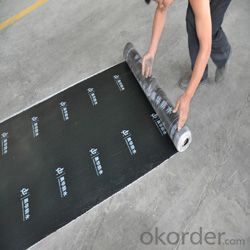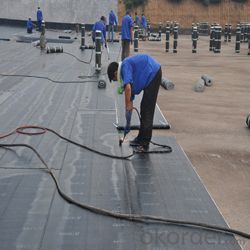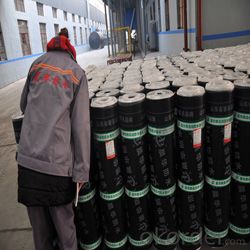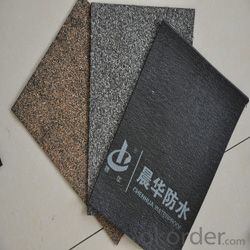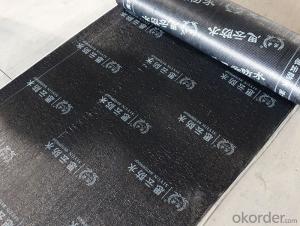APP modified bitumen waterproof membrane
OKorder Service Pledge
OKorder Financial Service
You Might Also Like
Specification:
Width:1m
Length/roll:7.5m/10m/15m or as your need.
Surface:PE film/Granules/Sand etc.
Thickness:3mm\4mm.
Characteristic:
a) SBS modified bitumen waterproof membrane is specially used as waterproof material in cold area
b) APP is specially suitable for areas of high temperature and of strong sun-shine
SBS/APP Modified Bitumen Waterproof Membrane
c)Good performance in good impermeability ,anti-puncture, anti-broker, anti-resistance, anti-erosion, anti-mildew, anti-weathering
d)Possess good tensile strength, elongation rate and size stability which could be well suited the substrate
distortion and crack
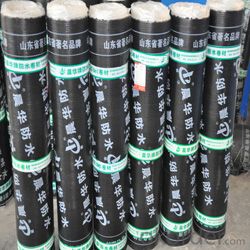
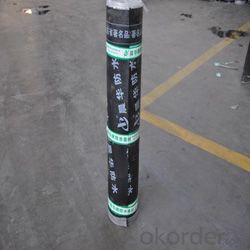
- Q: Can a waterproofing membrane be pre-fabricated or pre-made for easy installation?
- Yes, a waterproofing membrane can be pre-fabricated or pre-made for easy installation. Pre-fabricated membranes are manufactured in controlled environments, allowing for consistent quality and performance. They are designed to be installed quickly and easily, reducing labor time and cost. Pre-made membranes also ensure a precise fit and minimize the risk of installation errors. Overall, pre-fabricated or pre-made waterproofing membranes offer convenience and efficiency in the installation process.
- Q: Can a waterproofing membrane be used in areas with high levels of salt or saltwater exposure?
- Yes, a waterproofing membrane can be used in areas with high levels of salt or saltwater exposure. Waterproofing membranes are designed to provide a protective barrier against moisture, including saltwater. They are often used in coastal regions, marine environments, or areas with high salt content in the soil to prevent water damage and corrosion.
- Q: Can a waterproofing membrane be used in cold climates?
- Yes, a waterproofing membrane can be used in cold climates. In fact, it is highly recommended to use a waterproofing membrane in cold climates to protect structures from moisture damage caused by snow, ice, and freezing temperatures. Waterproofing membranes are designed to be flexible and durable, allowing them to withstand extreme temperature fluctuations without cracking or deteriorating. They create a barrier that prevents water from seeping into the structure, which is crucial in cold climates where water can freeze and expand, causing significant damage to buildings and infrastructure. Additionally, some waterproofing membranes are specifically formulated to perform well in cold weather conditions, offering enhanced resistance to freeze-thaw cycles and ensuring long-term protection against water infiltration. Therefore, it is essential to use a quality waterproofing membrane in cold climates to maintain the integrity and longevity of structures.
- Q: Does a waterproofing membrane require any special cleaning or maintenance procedures?
- Yes, a waterproofing membrane typically requires special cleaning and maintenance procedures to ensure its effectiveness and longevity. Regular inspections, cleaning off debris, and addressing any damage or wear are essential to prevent leaks or deterioration. Additionally, specific cleaning products and techniques may be recommended by the manufacturer or installer to maintain the membrane's performance.
- Q: Can a waterproofing membrane be used on asphalt surfaces?
- Indeed, asphalt surfaces can benefit from the application of a waterproofing membrane. These membranes, widely employed in construction, are specifically engineered to safeguard against water infiltration. Their versatility allows for application on diverse surfaces, asphalt included. By applying a waterproofing membrane on an asphalt surface, one can effectively thwart water damage, prolong the surface's lifespan, and safeguard the underlying structures. It is crucial to guarantee the compatibility of the chosen waterproofing membrane with asphalt and to adhere to proper installation techniques in order to achieve the best possible outcome.
- Q: Can a waterproofing membrane be used for foundation waterproofing?
- Yes, a waterproofing membrane can be used for foundation waterproofing. A waterproofing membrane is a thin layer of material that is applied to the exterior of a foundation to prevent water from seeping into the building. It acts as a barrier against moisture and helps to keep the foundation dry and protected.
- Q: Can waterproofing membranes be used on concrete countertops?
- Yes, waterproofing membranes can be used on concrete countertops. These membranes are designed to create a barrier that prevents water from seeping into the concrete, protecting it from damage and increasing its lifespan.
- Q: Roof SBS waterproofing membrane can not empty shop
- 2, a new SBS waterproofing membrane, with mechanical fixation construction, this material can be basically the same as the PVC shop.
- Q: Can a waterproofing membrane be used on both interior and exterior walls?
- Indeed, it is possible to utilize a waterproofing membrane on both the inner and outer walls. Said membranes are specifically devised to thwart the infiltration of water or moisture into the walls, irrespective of their positioning within a structure. Typically, these membranes are crafted from materials like rubber, modified bitumen, or liquid-applied coatings, which serve as a potent barricade against water seepage. Through the application of a waterproofing membrane on both the interior and exterior walls, one can guarantee the prolonged defense of the building against water-related harm, such as mold proliferation and other moisture-induced predicaments.
- Q: Can a waterproofing membrane be used on tunnels with water drainage systems?
- Tunnels with water drainage systems can indeed utilize a waterproofing membrane. The purpose of this membrane is to create a protective barrier against water infiltration and effectively prevent any leakage into the tunnel. However, it is crucial to ensure that the waterproofing membrane is compatible with the specific water drainage system in place. The installation of the membrane must be done in a manner that does not hinder or disrupt the functioning of the drainage system. Moreover, it is important to carefully consider the design and installation of the drainage system to ensure efficient water management and avoid any potential complications that may compromise the effectiveness of the waterproofing membrane. By carefully planning and executing the installation, a waterproofing membrane can effectively uphold the overall integrity and durability of tunnels with water drainage systems.
Send your message to us
APP modified bitumen waterproof membrane
OKorder Service Pledge
OKorder Financial Service
Similar products
Hot products
Hot Searches
Related keywords







